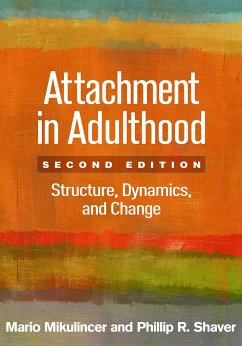Mario Mikulincer, Phillip Shaver, Phillip R. Shaver
Attachment in Adulthood, Second Edition
Structure, Dynamics, and Change
Mario Mikulincer, Phillip Shaver, Phillip R. Shaver
Attachment in Adulthood, Second Edition
Structure, Dynamics, and Change
- Broschiertes Buch
- Merkliste
- Auf die Merkliste
- Bewerten Bewerten
- Teilen
- Produkt teilen
- Produkterinnerung
- Produkterinnerung
Synthesizing a vast body of empirical research and organizing it around a comprehensive conceptual model, this book is recognized as the definitive reference on adult attachment. The authors explain how what began as a theory of child development is now used to conceptualize and study nearly all aspects of social functioning across the lifespan, including mental representations of self and others, emotion regulation, personal goals and strivings, couple relationships, caregiving, sexuality, psychopathology, psychotherapy, and organizational behavior.
Andere Kunden interessierten sich auch für
![Super Human Super Human]() Dave AspreySuper Human18,99 €
Dave AspreySuper Human18,99 €![Quality Learning for Positive Ageing Quality Learning for Positive Ageing]() Alan PotterQuality Learning for Positive Ageing37,99 €
Alan PotterQuality Learning for Positive Ageing37,99 €![Socio-gerontechnology Socio-gerontechnology]() Socio-gerontechnology65,99 €
Socio-gerontechnology65,99 €![But You're Still So Young But You're Still So Young]() Kayleen SchaeferBut You're Still So Young16,99 €
Kayleen SchaeferBut You're Still So Young16,99 €![Your Unique Self Your Unique Self]() Marc GafniYour Unique Self36,99 €
Marc GafniYour Unique Self36,99 €![Triumphs of Experience Triumphs of Experience]() George E. VaillantTriumphs of Experience21,99 €
George E. VaillantTriumphs of Experience21,99 €![Crime, Punishment, and the Elderly Crime, Punishment, and the Elderly]() Crime, Punishment, and the Elderly200,99 €
Crime, Punishment, and the Elderly200,99 €-
-
-
Synthesizing a vast body of empirical research and organizing it around a comprehensive conceptual model, this book is recognized as the definitive reference on adult attachment. The authors explain how what began as a theory of child development is now used to conceptualize and study nearly all aspects of social functioning across the lifespan, including mental representations of self and others, emotion regulation, personal goals and strivings, couple relationships, caregiving, sexuality, psychopathology, psychotherapy, and organizational behavior.
Hinweis: Dieser Artikel kann nur an eine deutsche Lieferadresse ausgeliefert werden.
Hinweis: Dieser Artikel kann nur an eine deutsche Lieferadresse ausgeliefert werden.
Produktdetails
- Produktdetails
- Verlag: Guilford Publications
- 2 ed
- Seitenzahl: 690
- Erscheinungstermin: 15. November 2017
- Englisch
- Abmessung: 254mm x 177mm x 35mm
- Gewicht: 1186g
- ISBN-13: 9781462533817
- ISBN-10: 1462533817
- Artikelnr.: 48511823
- Herstellerkennzeichnung
- Libri GmbH
- Europaallee 1
- 36244 Bad Hersfeld
- 06621 890
- Verlag: Guilford Publications
- 2 ed
- Seitenzahl: 690
- Erscheinungstermin: 15. November 2017
- Englisch
- Abmessung: 254mm x 177mm x 35mm
- Gewicht: 1186g
- ISBN-13: 9781462533817
- ISBN-10: 1462533817
- Artikelnr.: 48511823
- Herstellerkennzeichnung
- Libri GmbH
- Europaallee 1
- 36244 Bad Hersfeld
- 06621 890
Mario Mikulincer, PhD, is Professor of Psychology and Provost of the Interdisciplinary Center (IDC) Herzliya in Israel. His research interests include attachment styles in adulthood, terror management theory, personality processes in interpersonal relationships, evolutionary psychology, human learned helplessness and depression, trauma and posttraumatic processes, coping with stress, qualitative research on emotional states, and mental rumination and self-focused attention. Dr. Mikulincer is a fellow of the American Psychological Society and the Society for Personality and Social Psychology. He is a recipient of Israel's EMET Prize for Art, Science, and Culture. Phillip R. Shaver, PhD, is Distinguished Professor Emeritus of Psychology at the University of California, Davis. He has published several books, including Handbook of Attachment, Third Edition, and over 250 journal articles and book chapters. Dr. Shaver's research focuses on attachment, human motivation and emotion, close relationships, personality development, and the effects of meditation on behavior and brain. He is a fellow of both the American Psychological Association and the Association for Psychological Science and is past president of the International Association for Relationship Research, which honored him with its Distinguished Career Award. He has also received Distinguished Career Awards from the Society of Experimental Social Psychology and the Society for Personality and Social Psychology, and an honorary doctorate from the Faculty of Social Sciences at the University of Stockholm, Sweden. He is an elected member of the American Academy of Arts and Sciences.
I. The Attachment Behavioral System: Normative Processes and Individual
Differences
1. The Attachment Behavioral System: Basic Concepts and Principles
2. A Model of Attachment-System Functioning and Dynamics in Adulthood
3. Normative Attachment Processes
4. Measurement of Attachment-Related Constructs in Adulthood
5. Individual Differences in Attachment-System Functioning: Development,
Stability, and Change
II. Intrapersonal Aspects of Attachment-System Functioning
6. Attachment-Related Mental Representations of Self and Others
7. Attachment Processes and Emotion Regulation
8. Attachment Orientations, Behavioral Self-Regulation, and Personal Growth
III. Interpersonal Manifestations of Attachment-System Functioning
9. An Attachment Perspective on Interpersonal Regulation
10. Attachment Processes and Couple Functioning
11. Relations between the Attachment and Caregiving Systems
12. Attachment and Sex
IV. Clinical and Organizational Applications of Attachment Theory
13. Attachment Bases of Psychopathology
14. Implications of Attachment Theory and Research for Counseling and
Psychotherapy
15. Applications of Attachment Theory and Research in Group and
Organizational Settings
V. Epilogue
16. Reflections on Attachment Security
Appendices
Appendix A. Adult Attachment Questionnaire (AAQ)
Appendix B. Adult Attachment Scale (AAS)
Appendix C. Attachment Style Questionnaire (ASQ)
Appendix D. Relationship Style Questionnaire (RSQ)
Appendix E. Experiences in Close Relationships Scale (ECR)
Appendix F. ECR-R Items
Appendix G. Experiences in Close Relationships Scale (ECR)-Short Version
Appendix H. ECR-12: A Brief Version of the Experiences in Close
Relationships Scale (ECR)
Appendix I. State Adult Attachment Measure (SAAM)
Appendix J. Experiences in Close Relationships--Relationship Structures
Measure (ECR-RS)
Appendix K. Caregiving System Scale (CSS)
Appendix L. Caregiving Questionnaire
Appendix M. Sexual System Functioning Scale (SSFS)
References
Index
Differences
1. The Attachment Behavioral System: Basic Concepts and Principles
2. A Model of Attachment-System Functioning and Dynamics in Adulthood
3. Normative Attachment Processes
4. Measurement of Attachment-Related Constructs in Adulthood
5. Individual Differences in Attachment-System Functioning: Development,
Stability, and Change
II. Intrapersonal Aspects of Attachment-System Functioning
6. Attachment-Related Mental Representations of Self and Others
7. Attachment Processes and Emotion Regulation
8. Attachment Orientations, Behavioral Self-Regulation, and Personal Growth
III. Interpersonal Manifestations of Attachment-System Functioning
9. An Attachment Perspective on Interpersonal Regulation
10. Attachment Processes and Couple Functioning
11. Relations between the Attachment and Caregiving Systems
12. Attachment and Sex
IV. Clinical and Organizational Applications of Attachment Theory
13. Attachment Bases of Psychopathology
14. Implications of Attachment Theory and Research for Counseling and
Psychotherapy
15. Applications of Attachment Theory and Research in Group and
Organizational Settings
V. Epilogue
16. Reflections on Attachment Security
Appendices
Appendix A. Adult Attachment Questionnaire (AAQ)
Appendix B. Adult Attachment Scale (AAS)
Appendix C. Attachment Style Questionnaire (ASQ)
Appendix D. Relationship Style Questionnaire (RSQ)
Appendix E. Experiences in Close Relationships Scale (ECR)
Appendix F. ECR-R Items
Appendix G. Experiences in Close Relationships Scale (ECR)-Short Version
Appendix H. ECR-12: A Brief Version of the Experiences in Close
Relationships Scale (ECR)
Appendix I. State Adult Attachment Measure (SAAM)
Appendix J. Experiences in Close Relationships--Relationship Structures
Measure (ECR-RS)
Appendix K. Caregiving System Scale (CSS)
Appendix L. Caregiving Questionnaire
Appendix M. Sexual System Functioning Scale (SSFS)
References
Index
I. The Attachment Behavioral System: Normative Processes and Individual
Differences
1. The Attachment Behavioral System: Basic Concepts and Principles
2. A Model of Attachment-System Functioning and Dynamics in Adulthood
3. Normative Attachment Processes
4. Measurement of Attachment-Related Constructs in Adulthood
5. Individual Differences in Attachment-System Functioning: Development,
Stability, and Change
II. Intrapersonal Aspects of Attachment-System Functioning
6. Attachment-Related Mental Representations of Self and Others
7. Attachment Processes and Emotion Regulation
8. Attachment Orientations, Behavioral Self-Regulation, and Personal Growth
III. Interpersonal Manifestations of Attachment-System Functioning
9. An Attachment Perspective on Interpersonal Regulation
10. Attachment Processes and Couple Functioning
11. Relations between the Attachment and Caregiving Systems
12. Attachment and Sex
IV. Clinical and Organizational Applications of Attachment Theory
13. Attachment Bases of Psychopathology
14. Implications of Attachment Theory and Research for Counseling and
Psychotherapy
15. Applications of Attachment Theory and Research in Group and
Organizational Settings
V. Epilogue
16. Reflections on Attachment Security
Appendices
Appendix A. Adult Attachment Questionnaire (AAQ)
Appendix B. Adult Attachment Scale (AAS)
Appendix C. Attachment Style Questionnaire (ASQ)
Appendix D. Relationship Style Questionnaire (RSQ)
Appendix E. Experiences in Close Relationships Scale (ECR)
Appendix F. ECR-R Items
Appendix G. Experiences in Close Relationships Scale (ECR)-Short Version
Appendix H. ECR-12: A Brief Version of the Experiences in Close
Relationships Scale (ECR)
Appendix I. State Adult Attachment Measure (SAAM)
Appendix J. Experiences in Close Relationships--Relationship Structures
Measure (ECR-RS)
Appendix K. Caregiving System Scale (CSS)
Appendix L. Caregiving Questionnaire
Appendix M. Sexual System Functioning Scale (SSFS)
References
Index
Differences
1. The Attachment Behavioral System: Basic Concepts and Principles
2. A Model of Attachment-System Functioning and Dynamics in Adulthood
3. Normative Attachment Processes
4. Measurement of Attachment-Related Constructs in Adulthood
5. Individual Differences in Attachment-System Functioning: Development,
Stability, and Change
II. Intrapersonal Aspects of Attachment-System Functioning
6. Attachment-Related Mental Representations of Self and Others
7. Attachment Processes and Emotion Regulation
8. Attachment Orientations, Behavioral Self-Regulation, and Personal Growth
III. Interpersonal Manifestations of Attachment-System Functioning
9. An Attachment Perspective on Interpersonal Regulation
10. Attachment Processes and Couple Functioning
11. Relations between the Attachment and Caregiving Systems
12. Attachment and Sex
IV. Clinical and Organizational Applications of Attachment Theory
13. Attachment Bases of Psychopathology
14. Implications of Attachment Theory and Research for Counseling and
Psychotherapy
15. Applications of Attachment Theory and Research in Group and
Organizational Settings
V. Epilogue
16. Reflections on Attachment Security
Appendices
Appendix A. Adult Attachment Questionnaire (AAQ)
Appendix B. Adult Attachment Scale (AAS)
Appendix C. Attachment Style Questionnaire (ASQ)
Appendix D. Relationship Style Questionnaire (RSQ)
Appendix E. Experiences in Close Relationships Scale (ECR)
Appendix F. ECR-R Items
Appendix G. Experiences in Close Relationships Scale (ECR)-Short Version
Appendix H. ECR-12: A Brief Version of the Experiences in Close
Relationships Scale (ECR)
Appendix I. State Adult Attachment Measure (SAAM)
Appendix J. Experiences in Close Relationships--Relationship Structures
Measure (ECR-RS)
Appendix K. Caregiving System Scale (CSS)
Appendix L. Caregiving Questionnaire
Appendix M. Sexual System Functioning Scale (SSFS)
References
Index








